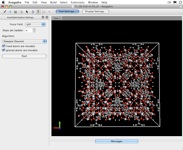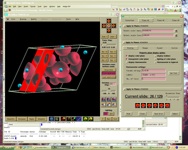An update on earlier entries on visualization tools. My requirements are structure visualization/manipulation on Windows and Mac. Here are some free programs that do the trick:
(a) VESTA
VESTA replaced VEND and VICS-II, and is a program that I use daily. Crystal structure visualization is fast and smooth, and you are free to transform your lattice any way you wish. On top of that, 2D and 3D plotting of data-sets is simple, and you can add atomic vectors to visualize magnetic moments/phonon eigenvectors. It can read many file formats natively and is compiled for most operating systems. It will even compute Madelung energies! Room for Improvement: Surface generation and symmetry finding.
(b) Avogadro
Cross-platform, lightning fast and beautiful graphics: a code with true style. Just look at the isosurfaces on the author’s blog; made in conjunction with POVRAY. Support for both finite and infinite systems with no shortage of display settings. It even comes with a database of molecular fragments. Not yet as robust as VESTA, but it definitely has a lot of potential. Room for Improvement: Lattice planes, symmetry finding, surface cutting, support for periodic code file formats.
(c) Aten
A Northern Irish newcomer into a not so crowded field. Taking inspiration from the wealth of excellent molecular visualization packages, Aten aims to match those functionalities and extend to periodic systems. At the moment, it performs the basics: it can import a handful of structure file formats and overlay 3D datasets. Room for Improvement: The visualization just doesn’t seem quite right: there are no options for polyedra or bond control, and the menus are a little too scattered.
(d) XCrySden
Originally aimed at Wien2K, but there are plenty of scripts around to convert VASP files and it now natively supports files from CRYSTAL and Quantum-Espresso. A very powerful program, which can automatically generate the first Brillouin zone for your cell, display good structures and produce decent density isosurfaces. Room for Improvement: Better support for platforms other than Unix, and its speed doesn’t come close to VESTA or Avogadro.
(e) Loose ends: Codes that I installed at some stage, but have been gathering dust since: Vaspview; P4VASP; WXDragon; STRender; Lev00 (this one actually has a huge array of features, I’ve just not had the time to play in detail). VMD will do a good job visualizing dynamics, but for anything more involved in relation to periodic systems, I find it far too limited (frustrating).



